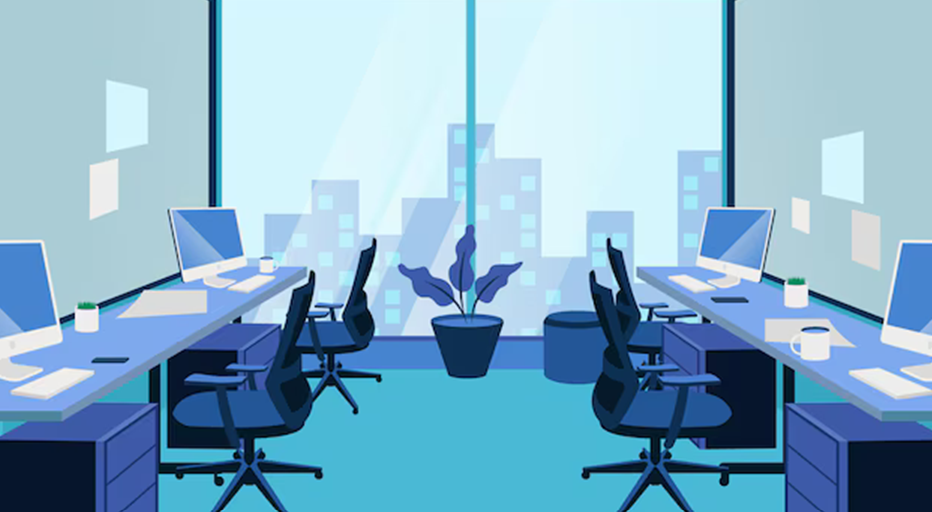In recent years, the open floor plan has emerged as the hallmark of modern office design, symbolizing collaboration, transparency, and adaptability. However, as organizations go deeper into the complexities of workplace dynamics, the once-revealed open floor plan is facing increased scrutiny.
While it undeniably offers advantages, its drawbacks cannot be overlooked. In this comprehensive exploration of office design, let’s look at what the open floor is all about and what alternatives modern architecture has to offer.
Table of Contents
Understanding the Open Floor Plan
The open-floor office design is a type of workspace where there are no walls or partitions dividing people into separate rooms. Instead, everyone works together in one big area. It started becoming popular in the 20th century as a way to encourage communication and collaboration among employees.
There are different variations of the open-floor office design. Some have long tables where everyone sits together, while others have clusters of desks spread out across the space. Some offices even have cozy seating areas or small meeting rooms mixed in with the open space. The idea is to create an environment where people can easily talk to each other and share ideas without barriers getting in the way.
Overall, the design is meant to make the workplace feel more open and friendly. It’s supposed to break down the walls, both literally and figuratively, that separate people and departments. However, while it can be great for promoting teamwork and creativity, some people find it challenging to concentrate with so much noise and activity around them. That’s why companies need to consider the needs of all their employees when designing their office layout.
The Downside of Open Floor Plans
Despite its popularity, the open floor plan is not without its challenges. While it promotes collaboration and transparency, it also introduces several disadvantages that can impact employee well-being and productivity.
One significant concern is the lack of privacy and noise control inherent in open environments. With no barriers to block sound or visual distractions, conversations and ambient noise can easily permeate the workspace. This constant buzz can disrupt concentration and hinder productivity, particularly for tasks that require focused attention. Additionally, individuals who thrive in quiet, secluded spaces may struggle to concentrate amidst the hustle and bustle of an open office layout.
Moreover, the open layout may inadvertently hinder collaboration rather than facilitate it. While it encourages spontaneous interactions, studies suggest that the quality of communication may suffer in a shared space. Employees may feel self-conscious or hesitant to voice their opinions, fearing judgment or interruption. This can create barriers to effective collaboration and impede the flow of ideas between teams and departments.
Furthermore, the lack of privacy in open floor plans can have implications for sensitive conversations and confidential work. Without designated spaces for confidential discussions, employees may feel uncomfortable discussing sensitive matters or sharing confidential information in a shared environment. This can undermine trust and confidentiality within the organization, potentially leading to legal or ethical issues.
The Shift Towards Alternative Office Layouts
In response to the limitations of open floor plans, many organizations are embracing alternative office layouts that strike a balance between collaboration and individual productivity. Here, we explore four distinct approaches gaining traction in the modern workplace.
Team-Based Layouts
Unlike traditional open floor plans where everyone works together in one big space, team-based layouts allocate separate zones for different teams to work together more closely. This concept began to gain popularity as companies recognized the importance of teamwork and wanted to create environments that fostered better collaboration and productivity.
Each team typically has its own designated area, with desks or workstations arranged nearby. This allows team members to interact easily, share ideas, and work together on projects without being interrupted by members of other teams. Additionally, these layouts often include shared spaces such as meeting rooms, lounges, or breakout areas where teams can gather for discussions, brainstorming sessions, or informal meetings.
In smaller companies or startups, teams may be organized by function (e.g., marketing, sales, engineering) and work closely together in a shared space. In larger organizations, teams may be organized by project or initiative, with each team having its own dedicated area within a larger office.
Overall, team-based office layouts aim to create a sense of belonging and identity within each team while still promoting collaboration and communication across the organization. By providing dedicated spaces for teams to work together, these layouts can help improve teamwork, productivity, and employee satisfaction.
Cubicle Farms: Finding Solace in Seclusion
Cubicle farms are like a maze of small, square workspaces called cubicles. Each cubicle has walls or partitions around it, giving workers their own little space to do their jobs. It started becoming popular in the 1960s and 1970s as a way to make offices more organized and efficient.
Contrary to what most people believe, cubicles come in all shapes and sizes. Some are tall with high walls, giving workers more privacy and blocking out noise. Others are short with low walls, making it easier for people to see and talk to each other. Some cubicles even have desks that can be adjusted up or down, so people can stand or sit while they work. Depending on the size of the office and the workforce, companies often have cubicles so large that they can be considered offices with low walls and no doors.

The idea behind the cubicle farm design is to give each employee their own space to focus and get their work done without distractions. It’s like having your own little office within a bigger office. However, some people find the cubicle farm layout isolating and uninspiring. They miss being able to see and interact with their coworkers easily. Overall, cubicles have their pros and cons. It can help employees concentrate and stay organized, but it can also feel cramped and lonely.
Activity-Based Workspaces
Activity-Based Workspaces have different areas that are designed for specific tasks or activities. Instead of having one desk for each person, employees can choose where to work based on what they need to do. This concept began gaining popularity in the early 2000s as companies looked for ways to make their offices more flexible and dynamic.
In activity-based workspaces, you might find areas for quiet, focused work, as well as spaces for collaboration and group meetings. There could also be zones for relaxation or socializing, like cozy seating areas or coffee corners. The idea is to provide a variety of environments that cater to the diverse needs and preferences of employees throughout the day. This inclusion of recreational areas has become more popular as employee satisfaction and well-being have become more important for corporations.
It also creates opportunities to accomplish a diverse set of goals. For instance, there are quiet zones where people can go when they need to concentrate without distractions. Another variation is the collaboration area with large tables and whiteboards for team meetings and brainstorming sessions. Some offices even have designated “breakout rooms” where small groups can meet privately without disturbing others.
Activity-based workspaces offer employees the freedom to choose where and how they work, depending on what they need to accomplish. This flexibility can boost creativity, productivity, and employee satisfaction. However, companies need to provide enough variety and resources in each area to ensure that all employees can find a place. It has a wide set of advantages and is compatible with the expectations of the modern employee, but it can be expensive and difficult to manage.
Remote Work and Hot Desking
Even though the pandemic is over, the effects of the lockdown persist. It turns out that the most effective modern office may not be any office at all. Remote work and hot desks are modern approaches to office design that emphasize flexibility and autonomy for employees.
Remote work allows employees to do their jobs from anywhere, whether it’s from home, a coffee shop, or a co-working space. This concept began gaining traction with the advancement of technology, such as high-speed internet and collaboration tools, which made it possible for people to stay connected and productive outside of the traditional office setting.
Hot desking, on the other hand, refers to a flexible seating arrangement where employees don’t have assigned desks. Instead, they can choose any available workspace when they come into the office. This approach aims to maximize space utilization and encourage collaboration by breaking down physical barriers between teams and departments.
For employees, remote work provides a greater work-life balance and eliminates the need for long commutes, while hot desking offers flexibility and variety in the work environment. For employers, these approaches can reduce overhead costs associated with maintaining a large office space and attract top talent with flexibility. The great thing about both of these approaches is that you can edit them according to your needs. Some companies allow employees to work remotely full-time, while others offer it as an option a few days a week. Similarly, hot desks can range from completely unassigned seating to a hybrid model where employees have designated spaces for certain days or times.
While the open floor plan is still the first choice for many organizations, its limitations are becoming increasingly apparent. By embracing alternative office layouts such as cubicle farms, activity-based workspaces, remote work arrangements, or hybrid models, organizations can create spaces that cater to diverse work styles and preferences.
For more similar blogs, visit EvolveDash today!
FAQs
- Are open floor plans cheaper to implement than other office layouts?
Yes, they often reduce construction costs since fewer walls and partitions are needed. However, additional costs for noise-canceling solutions and private meeting spaces can arise.
- Do open offices increase workplace distractions?
Yes, many employees find them distracting due to noise and lack of privacy, which can lower productivity.
- How do companies address privacy concerns in open offices?
Some use phone booths, meeting pods, or soundproof barriers to provide private spaces for calls and confidential work.
- Is employee satisfaction higher in open floor offices?
Not always. While some enjoy the collaborative atmosphere, others struggle with noise and interruptions, leading to mixed opinions.
- Can hybrid work reduce the downsides of open offices?
Yes, allowing employees to work remotely part-time can help balance collaboration in the office with quiet, focused work at home.



















